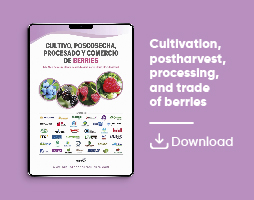Actualidad
Azoxystrobin in in vitro assays inhibites but not stops Colletotrichum eriobotryae in loquat
Loquat (Eriobotrya japonica) is an economically important but minor fruit crop in central Taiwan. Anthracnose fruit rot is an important postharvest disease of loquat. However, not much is known about this disease in Taiwan. In this study, the fungi causing anthracnose fruit rot of loquat in Taiwan were identified using morphological and molecular approaches. Based on ITS sequence data, isolates from diseased loquat fruit, collected in the main cultivation areas in central Taiwan, were identified as Colletotrichum species belonging to clade 2 of the C. acutatum species complex. Phylogenetic analyses of the ITS, GAPDH, CHS-1, HIS3, ACT, and TUB2 sequences placed one isolate in C. nymphaeae, while the other isolates were distinct from all known Colletotrichum species and described as C. eriobotryae
03 July, 2020
Redaccion
Loquat (Eriobotrya japonica) is an economically important but minor fruit crop in central Taiwan. Anthracnose fruit rot is an important postharvest disease of loquat. However, not much is known about this disease in Taiwan. In this study, the fungi causing anthracnose fruit rot of loquat in Taiwan were identified using morphological and molecular approaches. Based on ITS sequence data, isolates from diseased loquat fruit, collected in the main cultivation areas in central Taiwan, were identified as Colletotrichum species belonging to clade 2 of the C. acutatum species complex. Phylogenetic analyses of the ITS, GAPDH, CHS-1, HIS3, ACT, and TUB2 sequences placed one isolate in C. nymphaeae, while the other isolates were distinct from all known Colletotrichum species and described as C. eriobotryae sp. nov. Based on our data, both species can cause anthracnose fruit rot of loquat, but C. eriobotryae is the main pathogen of this disease in central Taiwan. The growth of both species was inhibited, but not completely stopped by azoxystrobin in in vitro assays. The growth inhibition increased by enhancing the concentration from 0.031 to 8 ?g/mL and by adding salicylhydroxamic acid, suggesting both species to have an alternative respiration pathway. Furthermore, C. citri was revealed to be a synonym of C. nymphaeae. SourcesColletotrichum eriobotryae sp. nov. and C. nymphaeae, the anthracnose pathogens of loquat fruit in central Taiwan, and their sensitivity to azoxystrobinUlrike Damm, Yun-Ching Sun & Chien-Jui HuangMycological Progress volume 19, pages367?380(2020)https://link.springer.com/article/10.1007/s11557-020-01565-9Picture by Sandra B. Ju?rez-V?zquez et al.,?Phylogenetic and morphological identification of Colletotrichum godetiae, a novel pathogen causing anthracnose on loquat fruits (Eriobotrya japonica)








